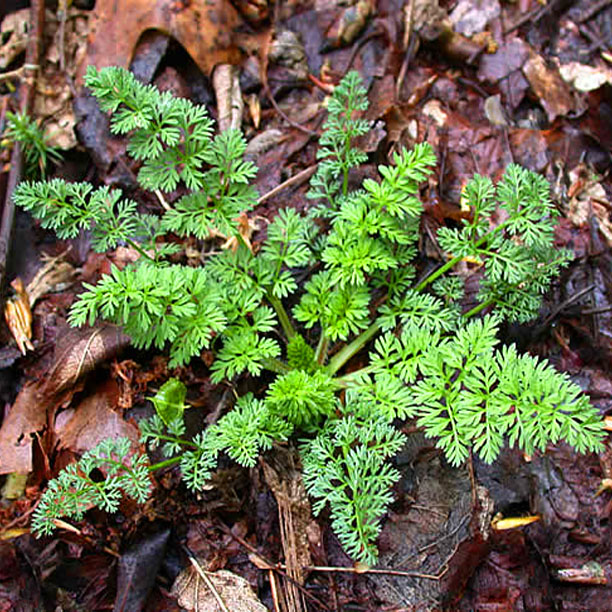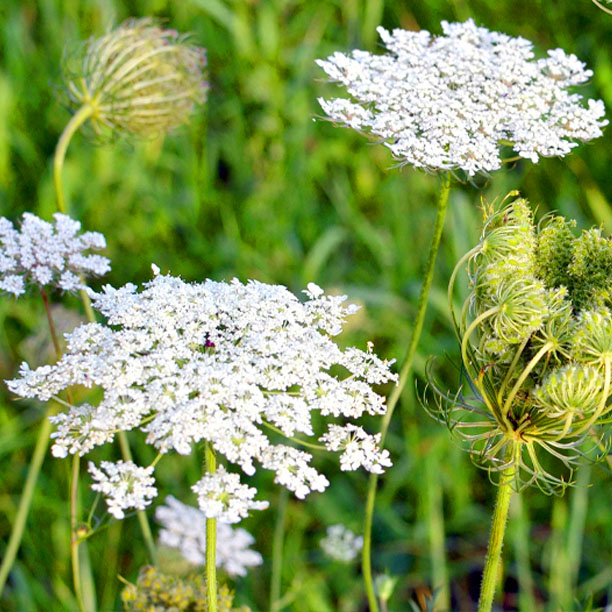Queen Anne’s Lace
How To Identify
WARNING! Queen Anne’s Lace or wild carrot looks very similar to Poison Hemlock. Please be absolutely certain in your identification before consuming any wild edible.
Queen Anne’s Lace leaves looks the same as domesticated or store-bought carrot leaves. They are finely divided, feathery leaves that smell like carrots when crushed and extend outward from a central taproot. The leaf stalks are hairy and only send up flower stalks in their second year which are also hairy. The flower head is flat and looks like a parasol of white lacey florets. There is sometimes a purple floret in the center of this parasol which confirms the plant as Queen Anne’s Lace. The flowers eventually fold up into a nest of hairy seeds that smell similar to fennel. Pulling or rather, digging the plant up will expose the taproot or carrot which will appear the same as a domestic carrot, only smaller and white in color. It will smell exactly like a carrot.
Poison Hemlock doesn’t smell like carrot, doesn’t have hairy leaf stalks or stems, doesn’t have a purple floret in the flowers center and the flowers don’t fold into nests of hairy seeds.


Benefits
Traditionally, tea made from the root of Queen Anne’s Lace has been used as diuretic to prevent and eliminate kidney stones, and to rid individuals of worms. The Mohegan Indians steeped the flowers into a tea as a diabetes treatment and a study from Harvard University concluded that eating more than five carrots a week greatly reduces the risk of stroke in the elderly.
How To Find
Wild carrots can be found in sunny fields, disturbed ground such as lots and in fringe areas where lawns meet the forest. They can be found year-round but first come up in early spring and bloom from late spring into fall.
Gathering
Since the entire plant is edible, you can either gather the upper portions (leaves, flowers, seeds) simply by cutting them off or if it’s the carrot that you are after, digging about 1 foot down to loosen the soil and then pulling the root up and out.
How To Use
Queen Anne’s Lace seeds contain volatile oils said to irritate the uterine lining thus causing an ovum to not implant, so it is HIGHLY advised that pregnant women and women trying to get pregnant avoid using Queen Anne’s Lace in any of it’s forms.
The roots of Wild carrot are edible and best when cooked, as they are thin and stringy when raw. The roots may even be dried, roasted and ground into a powder for a coffee substitute. The flowers are also a culinary treat. They may be fried as a whole cluster, steeped for an herbal tea or used to aromatize simple syrups and vinegars. The leaves are also edible and offer a delicious herbal carrot flavor to stocks and soups. Wild carrot seeds are very aromatic and may be dried and used as a caraway seed substitute.
Preservation
To preserve the leaves, flowers and seeds, place them into separate paper bags, or on a screen (window screen or similar) and allow them to dry in a dry dark place with good airflow. They can also be dehydrated using very low or no heat in a standard dehydrator or freeze dried. Oven drying isn’t recommended as the heat can damage the medicinal benefits. The roots, if tender enough, can be canned using the same method as for domestic carrots. They can also be roasted no matter how tender or tough and ground as a coffee extender. The grounds can be vacuumed sealed into jars and will keep for approximately 1 year.
December 30, 2023 @ 5:30 pm
fantastic points altogether, you simply won a new reader.